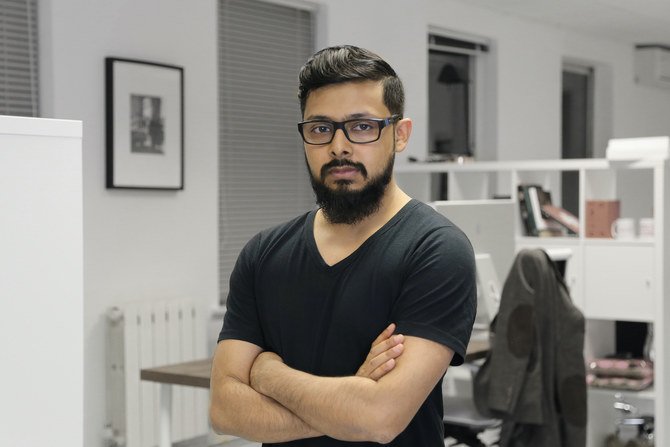
- ARAB NEWS
- 28 Apr 2024

Denise Marray
LONDON: ‘The pens have been lifted, and the pages have dried.’ (At-Tirmidhi, 2516)
This saying from the Hadith has been an inspiration for contemporary calligrapher Ruh Al-Alam, he tells Arab News.
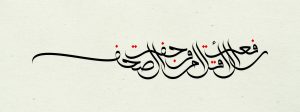
“The reference to the pens and inks resonated with me. This saying refers to the religion being complete — to the fact that Islam has been given to the people and there is nothing more to give; there is nothing more to be taught. There is no better way to present this message than through calligraphy,” he says.
A British artist of Bangladeshi descent, Al-Alam studied design at Central Saint Martins in London. After graduating, he spent several years in Cairo learning Arabic and studying calligraphy with esteemed teachers.
And while the message of the inspirational hadith that so inspired him may apply to Islam, Al-Alam’s work suggests that his chosen art from still has plenty to give. He sees calligraphy not as a calcified art but something present, alive and relevant. That is reflected in his own style, which has led to collaborations with major brands and organizations including Netflix, the BBC, the UK’s National Portrait Gallery, and Sony.
“When Sony launched the PlayStation Portable they used Arabic calligraphy to appeal to different audiences,” he says. “They wanted to use something unique to differentiate themselves from others in the market.”
His desire to make Islamic art accessible and current has been at the heart of his development as an artist.
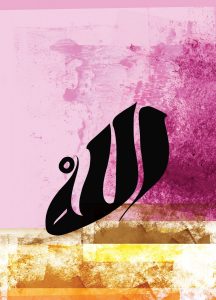
“I don’t want to restrict the use of calligraphic arts to just the traditional — I want to apply them in ways that are less common,” he says. “For example, early on when I wanted to decorate my home with artwork, I wanted to put something up that was more spiritually focused. That’s where Islamic art came in. I wanted to make sure I did something that reflected my faith, but couldn’t find anything that I could put up in a more contemporary home that reflected the identity of myself and my family.” So he applied his own imagination. “One God Allah” is a perfect example of Al-Alam’s modern take on the ancient art.
“I wanted to create an emotive piece with a lot of texture and to keep it really simple with strong, contrasting colors. You don’t often see red with a contrasting black or brown color — that’s the contemporary element,” he explains. “I am saying that a calligraphic work doesn’t need to be black ink on a white sheet — it can be different. An important element to consider is where the artwork will be displayed. It could be in a beautiful contemporary home or a workplace, but it is designed to be striking.”
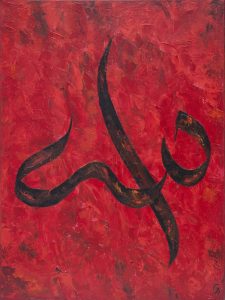
Al-Alam has also incorporated other items used or worn on a daily basis by devout Muslims into his work. He found that traditional prayer mats did not suit his home, so he created a limited edition of contemporary designs, which have proved so popular — even though they are expensive — that he is planning a new series in leather.
“I was tired of the regular wool-pile prayer mats — many are really badly designed and some do not follow Islamic artistic tradition,” he says. “Also, they don’t fit the lifestyles that a lot of people lead. I always like to leave my prayer mat open so I can leave it in the corner and go back to it. People want minimalist designs in different materials that adhere to Islamic art traditions and suit the design of their homes better.
“I charge a lot more for my prayer mats but they are something you can cherish and they became an instant hit. We sold out right away in the first year,” he said.
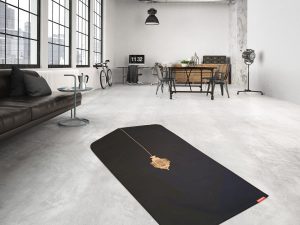
He has also extended his application of calligraphy to the hijab in a one-off series.
“Putting abstract calligraphy onto hijabs was a new idea at that time,” Al-Alam claims. “I wanted them to be practical but different. One of the things I had to make sure of was that the lettering on the hijab was not interpreted as being in any way religious, as scripture is not allowed on garments.”
Al-Alam explains that he has personal experience of being falsely accused of disrespecting religious writings. “About a decade ago, I designed some T-shirts and there was a problem in Egypt when a journalist claimed that I had put scripture on them — even to the point of getting a fatwah against me from an Azhari scholar. I then had to go on TV and refute him, at which point he acknowledged that he had not actually seen the T-shirts.”
Al-Alam has since built an international reputation and has received many honors — including the Islamic Economy Award for Islamic Arts, which he received from Dubai’s Sheikh Hamdan bin Mohammed Al-Maktoum in 2018 — in recognition of his pioneering work in contemporary Arabic typography and calligraphy.
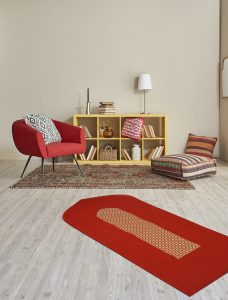
His calligraphic script styles include Spirit, Jude and Latin-Arabi, while his innovative Arabic typography includes Kufica, Arabic Didot and Moda. His design agency, Archetype, specializes in Arabic work.
“Right now we are talking to a Saudi client for whom we are designing several websites. We have designed many different logos and identities for clients in Saudi Arabia. I have also been to the Kingdom for religious purposes — for the Hajj and the Umrah and for work visits,” he says, adding that he is very impressed with the burgeoning art scene in Saudi Arabia.
“Artists like Ahmed Mater are amazing and I also see a lot of young artists and calligraphers who are passionately creating work,” he says. “There are a lot of naturally gifted people who are now expressing their talent and when this movement comes to fruition over the next decade it will change how the art of the Middle East is perceived.”